The information contained in this article is not intended as legal advice and may no longer be accurate due to changes in the law. Consult NHMA's legal services or your municipal attorney.
Citizen engagement in municipal, regional, and statewide planning processes is an ideal expression of people’s desire to make their communities better. From citizen’s forums, public hearings and local voting opportunities, to surveys and community- based activities, the engagement opportunities vary depending on the project. With one idea uniting them all, these engagement methods are designed to involve residents and align decision-making with the needs of people who live, work, and play in the community.
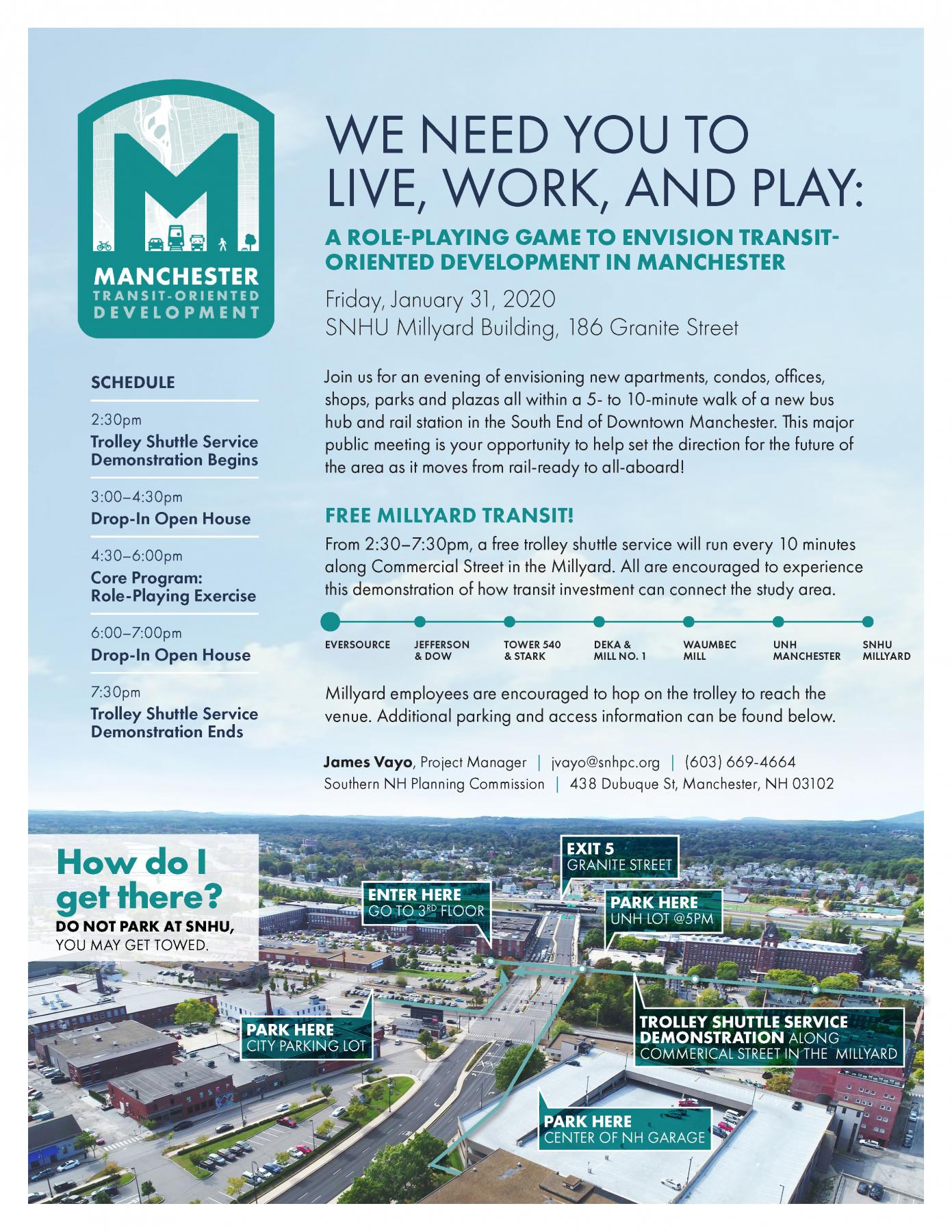
To set the stage for successful outcomes, planners need to identify outreach strategies early on in their projects and plan for meaningful citizen engagement throughout the entirety of the process. Relative to the role of regional planning commissions, certain planning realms like transportation, come with legal mandates for public engagement. To ensure outreach and engagement goals are met, it is important for planners to go beyond the minimum of legal mandates for public engagement and develop relationships with community partners, leverage overlapping interests in the project; design fun and interactive activities; and use new technology and innovations to enhance the outreach process.
While outreach and engagement strategies have changed over time with advancing technologies, traditional in-person approaches are still used frequently for a variety of projects and municipal processes. With that said, the COVID-19 pandemic has rapidly and substantially altered public engagement activities. Public entities have had to think outside the box when designing community involvement. Online forum tools like ZOOM and Microsoft Teams, as well as, survey platforms like SurveyMonkey, provide planners, municipal staff, volunteers, and agency partners a variety of approaches to engage stakeholders in the decision-making process.
Creative Regional Planning Commission Engagement
Prior to the COVID-19 pandemic, staff from Strafford Regional Planning Commission (SRPC) relied heavily on in-person outreach to inform the City of Dover’s Culture and Recreation Master Plan Chapter update. While both digital and face-to-face approaches were used, 740 of the 1,200 citizens engaged with the project were in-person participants.
SRPC created innovative activities to engage adults and children. For youth engagement, staff created a “design your dream park” sticker activity”, which was showcased at Dover’s Downtown Trick or Treat event. This included an 8.5 x 11 template and 20 different activities symbolized by iconized stickers where children could identify their favorite activities to include in their dream park. As a result, the commission received feedback from 150 children.
Staff also created a feedback loop, where they used input from previous events to inform and engage individuals at later outreach opportunities. Early on, SRPC staff asked project participants what type of public art they would like to see in Dover, and where.
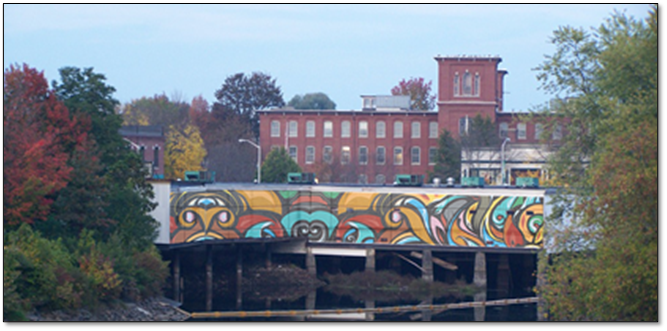
Photo: Photoshop Rendering of a mural on a building in Dover, New Hampshire.
Once a list was created, staff used photoshop to create renderings of what this art could look like, and brought these to an Art Walk event. Those participating in the Art Walk were invited to share their thoughts about each rendering. The community provided strong positive feedback to seeing the visuals of their ideas brought to life through the renderings.
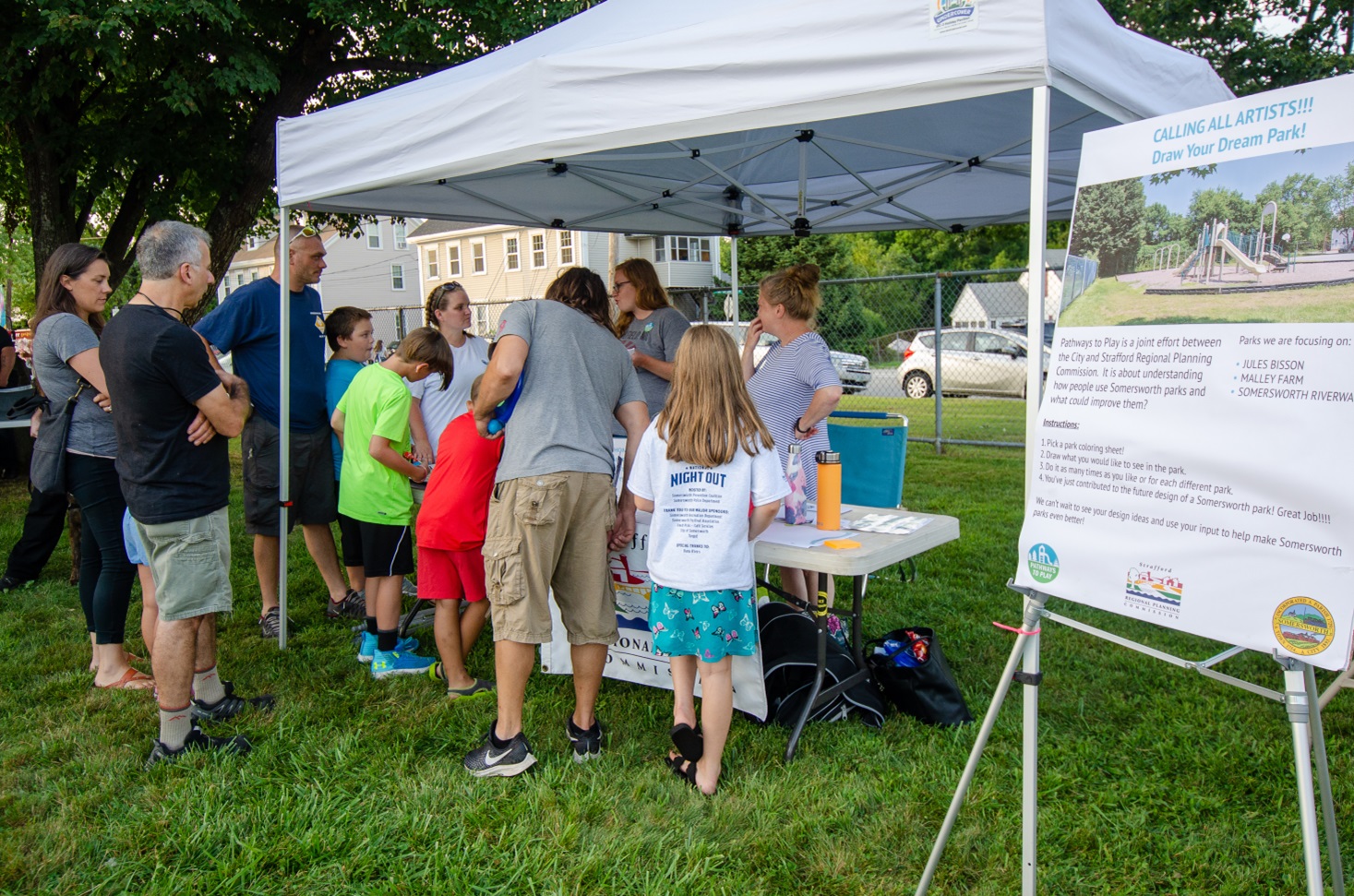
Photo: SRPC Staff at the Somersworth National Night Out Event for its Pathways to Play project.
When the Town of Goffstown engaged SNHPC to assist with their Master Plan, commission staff set out coordinating with town staff and local event organizers to ensure they could participate in Goffstown’s Old Home Day event. Planning commission staff set up a tent with visioning activities, oral surveys, and distributed postcards with links to an online survey in order to ensure a
broad spectrum of community members were engaged in the effort. Commission staff made sure to include activities for residents of all ages, including children. A table with Legos and other toys was set up under a tent to provide entertainment for children. The playing children provided an opportunity for parents and guardians to engage in the Master Plan activities.
In another project, SNHPC used a hybrid model in approaching outreach for a project known as the Manchester Transit-Oriented Development Plan. This included a combination of Facebook, email newsletters, and an interactive project website platform called CoUrbanize as a method for garnering online participation. This engagement method helped set the stage for in-person techniques later in the project. One such technique was as a role-playing game used to envision future uses of the project area. During the role-playing activity, participants were asked to assume the role of different people who would live and work in the project area. They were then asked to prioritize transportation investments that would best serve their character’s needs. The activity allowed participants to put their own priorities aside for a moment and consider how different investments may affect the choices of other potential community members based on their lifestyle and life stage. The result was a more focused approach to investment priorities that were a compromise of needs, where participants noted that their choice might go against their own priorities but make sense for the future inhabitants of the project area.
Engagement in a Post-Pandemic World
In what is often described as a “new normal”, planning staff, volunteers, or the public are unable to attend public events, hold in-person focus groups, or knock on doors to garner public opinion. This is leading to an increasing reliance on virtual means of citizen engagement. While this has presented new opportunities for some, such as increased attendance at public meetings now being held online, it has also excluded a part of the population who lack internet access. Planners are now asking the questions; how do we connect with those who do not have internet access, how do we reach our senior population who may not have experience with technology?
SRPC, in partnership with Greater Seacoast Community Health, recently launched a project to foster environments where people can grow and thrive equitably, regardless of age. As initially conceptualized in the grant application, the project planned and heavily depended upon in-person outreach activities. The COVID-19 pandemic led to a shift in that approach, especially considering the target population’s risk level.
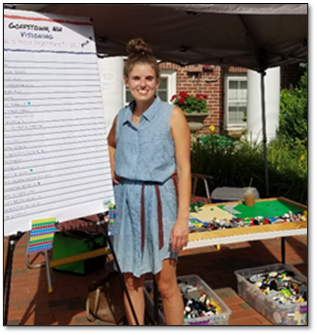
Photo: SNHPC Staff at Goffstown Old Home Day
As a result, staff are exploring innovative methods to engage residents. New approaches include hosting limited contact methods like surveys or open-ended questions at supermarkets, the
post office, doctor’s appointments, and through in-home care providers. Focus groups with seniors or youth that are already in proximity to each other such as in a senior living facility or at a summer camp can link facilitators with audiences via ZOOM. This offers the opportunity to hear from larger groups, encourage larger discussions, while mitigating health risks.
Art as a form of input presents another COVID-safe opportunity wherein participants create pieces in their own space that are then combined to create a mural. One such means to do so includes distributing stamped postcards to different locations that pose a question to be answered either with words or a drawing. Contributors mail their postcards to the planning commission staff to compile and display, or to create a gallery wall at their respective location.
Other approaches include having a paper survey delivered with Meals on Wheels or given to passengers who are using COAST’s demand response transit service. Respondents can complete
a survey while in the car on the way to the store or to a medical appointment. Equally, a short survey could be given at the end of a telehealth or in-person doctor’s appointment; a great opportunity to talk with older populations.
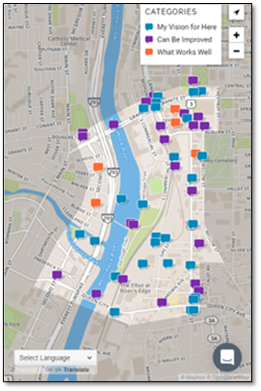
Photo: Manchester Transit-Oriented Development Plan Online Comments Map.
Noted earlier, SNHPC took a digital approach to innovative outreach for the Manchester Transit-Oriented Development Plan. The project team used a tool known as the CoUrbanize’ to share a “comments map” for the study area and gather public input. In doing so, the community was able to assist the planning effort by identifying the areas of interest within the project area. The comments offered a portal for the project team to engage citizens on an individual basis, within a public forum of the website. This allowed participants to ask questions in a similar way
that they would during an in-person meeting. This proved valuable to the planning process. The COVID pandemic quickly impacted daily life for many and presented a risk to the project’s planning process. This virtual engagement provided resilience to the overall outreach effort and remained an effective engagement tool as COVID impacted the state. These digital tools were further strengthened by reaching audiences that do not traditionally engage in the planning process.
The Manchester project will soon end, but the interactive website will continue to provide a valuable resource to the community as an online archive for all planning documents and public outreach. Materials to be archived for public access include all public comments, memos, reports, presentation slides, maps as well as the final plan. The online archiving component of
the plan will prove an effective way to build trust with community by demonstrating transparency in the decision- making process. When the project is complete, the plan will remain
documented and publicly available indefinitely, making the project website a reference for future efforts.
The above examples highlight the crucial role public engagement plays in planning. Without it, planners would be working in a void creating the opportunity for misunderstanding of the need and vision of communities as a whole. Getting out in public, either virtually or in-person, is a fulfilling component of work for planners. Planners are constantly working to learn and create new engagement opportunities that allow the maximum amount of people to influence decision-making process for planning initiatives. The aim is to create a greater sense of community through the outreach process, and to encourage the conversation to continue beyond funding deadlines or plans. Creating something dynamic and sustainable keeps members of the community interested in the process, and instills ownership, belonging, and equity. Moving forward we can expect to see our regional planning commissions use fun and interesting outreach strategies to continue the community conversation in New Hampshire’s towns and cities.
 New Hampshire Association of Regional Planning Commissions
New Hampshire Association of Regional Planning Commissions
James Vayo is Project Manager with the Southern New Hampshire Planning Commission. James may be reached at (603) 669.4664 x307 or by email at jvayo@snhpc.org.
Shayna Sylvia is a Communications and Outreach Planner with the Strafford County Regional Planning Commission. Shayna may be reached at (603) 994.3500 or by email at ssylvia@strafford.org.
Nancy O’Conner is a Equity and Engagement Planner with the Strafford Regional Planning Commission. Nancy may be reached at (603) 994.3500 or by email at noconnor@strafford.org